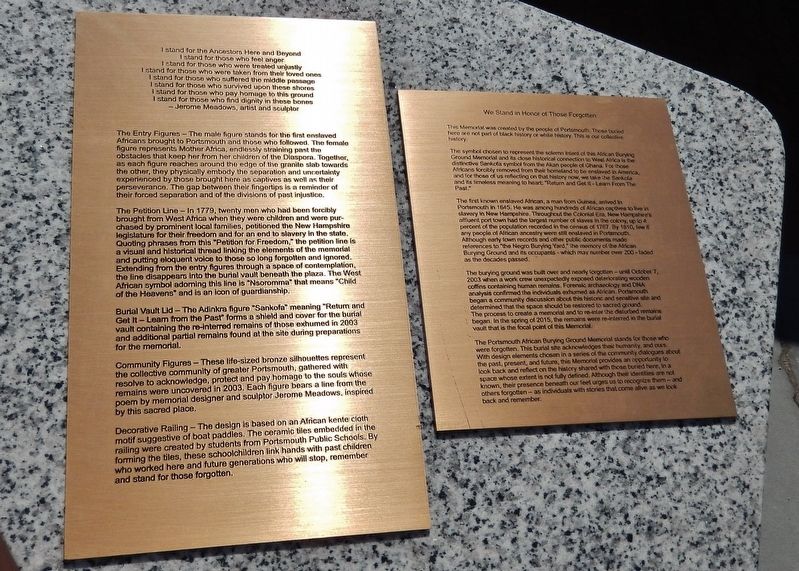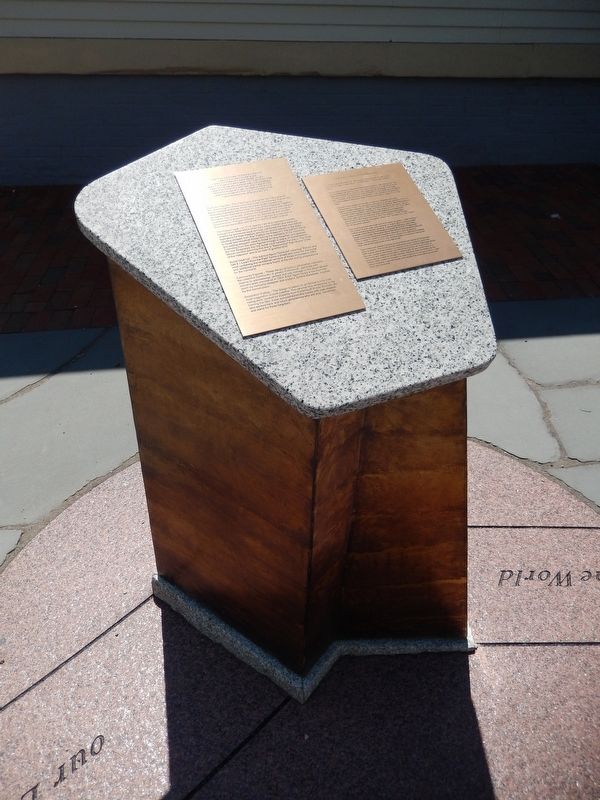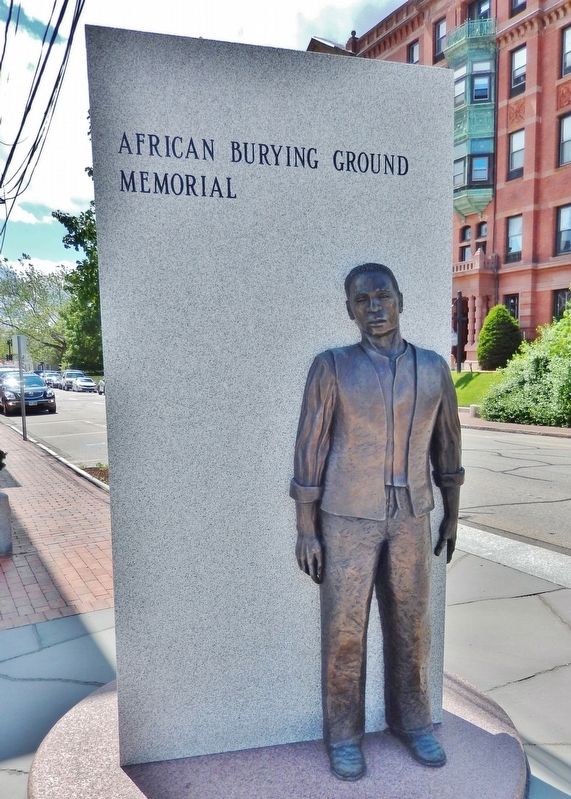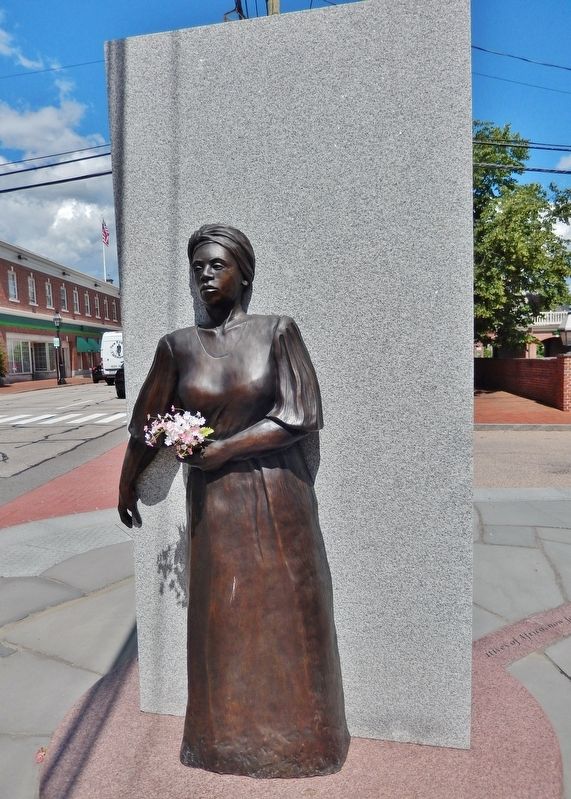Portsmouth in Rockingham County, New Hampshire — The American Northeast (New England)
African Burying Ground Memorial
(left panel)
I stand for those who feel anger
I stand for those who were treated unjustly
I stand for those who were taken from their loved ones
I stand for those who suffered the middle passage
I stand for those who survived upon these shores
I stand for those who pay homage to this ground
I stand for those who find dignity in these bones
— Jerome Meadows, artist and sculptor
The Entry Figures
The male figure stands for the first enslaved Africans brought to Portsmouth and those who followed. The female figure represents Mother Africa, endlessly straining past the obstacles that keep her from her children of the Diaspora. Together, as each figure reaches around the edge of the granite slab towards the other, they physically embody the separation and uncertainty experienced by those brought here as captives as well as their perseverance. The gap between their fingertips is a reminder of their forced separation and of the divisions of past injustice.
The Petition Line
In 1779, twenty men who had been forcibly brought from West Africa when they were children and were purchased by prominent local families, petitioned the New Hampshire legislature for their freedom and for an end to slavery in the state. Quoting phrases from this "Petition for Freedom," the petition line is a visual and historical thread linking the elements of the memorial and putting eloquent voice to those so long forgotten and ignored. Extending from the entry figures through a space of contemplation, the line disappears into the burial vault beneath the plaza. The West African symbol adorning this line is “Nsoromma" that means "Child of the Heavens” and is an icon of guardianship.
Burial Vault Lid
The Adinkra figure "Sankofa" meaning "Return and Get It — Learn from the Past” forms a shield and cover for the burial vault containing the re-interred remains of those exhumed in 2003 and additional partial remains found at the site during preparations for the memorial.
Community Figures
These life-sized bronze silhouettes represent the collective community of greater Portsmouth, gathered with resolve to acknowledge, protect and pay homage to the souls whose remains were uncovered in 2003. Each figure bears a line from the poem by memorial designer and sculptor Jerome Meadows, inspired by this sacred place.
Decorative Railing
The design is based on an African kente cloth motif suggestive of boat paddles. The ceramic tiles embedded in the railing were
created by students from Portsmouth Public Schools.
By forming the tiles, these schoolchildren link hands with past children who worked here and future generations who will stop, remember and stand for those forgotten.
(right panel)
This Memorial was created by the people of Portsmouth. Those buried here are not part of black history or white history. This is our collective history.
The symbol chosen to represent the solemn intent of this African Burying Ground Memorial and its close historical connection to West Africa is the distinctive Sankofa symbol from the Akan people of Ghana. For those Africans forcibly removed from their homeland to be enslaved in America, and for those of us reflecting on that history now, we take the Sankofa and its timeless meaning to heart: "Return and Get It - Learn From The Past."
The first known enslaved African, a man from Guinea, arrived in Portsmouth in 1645. He was among hundreds of African captives to live in slavery in New Hampshire. Throughout the Colonial Era, New Hampshire's affluent port town had the largest number of slaves in the colony, up to 4 percent of the population recorded in the census of 1767. By 1810, few if any people of African ancestry were still enslaved in Portsmouth. Although early town records and
other public documents made references to "the Negro Burying Yard," the memory of the African Burying Ground and its occupants - which may number over 200 - faded as the decades passed.
The burying ground was built over and nearly forgotten — until October 7, 2003 when a work crew unexpectedly exposed deteriorating wooden coffins containing human remains. Forensic archaeology and DNA analysis confirmed the individuals exhumed as African. Portsmouth began a community discussion about this historic and sensitive site and determined that the space should be restored to sacred ground. The process to create a memorial and to re-inter the disturbed remains began. In the spring of 2015, the remains were re-interred in the burial vault that is the focal point of this Memorial.
The Portsmouth African Burying Ground Memorial stands for those who were forgotten. This burial site acknowledges their humanity, and ours. With design elements chosen in a series of the community dialogues about the past, present, and future, this Memorial provides an opportunity to look back and reflect on the history shared with those buried here, in a space whose extent is not fully defined. Although their identities are not known, their presence beneath our feet urges us to recognize them — and others forgotten — as individuals with stories that come alive as we look
back and remember.
Erected 2015 by Portsmouth City Council and the African Burying Ground Committee.
Topics. This historical marker and memorial is listed in these topic lists: African Americans • Cemeteries & Burial Sites • Colonial Era.
Location. 43° 4.508′ N, 70° 45.542′ W. Marker is in Portsmouth, New Hampshire, in Rockingham County. Marker is on State Street (U.S. 1) east of Middle Street, on the right when traveling east. Marker is located at the center of the African Burying Ground Memorial at this address. This memorial plaza includes the entire area from State Street to Court Street on what was previously Chestnut Street but is now dedicated to this purpose. Touch for map. Marker is at or near this postal address: 386 State Street, Portsmouth NH 03801, United States of America. Touch for directions.
Other nearby markers. At least 8 other markers are within walking distance of this marker. Site of "Negro Burying Ground" (a few steps from this marker); Frank Jones's Hotels (within shouting distance of this marker); John Paul Jones House (about 400 feet away, measured in a direct line); Joseph & Nancy (Cotton) and their children, Eleazor & James (about 400 feet away); In This House Admiral (John) Paul Jones Resided (about 400 feet away); The Continental Frigate "Raleigh"
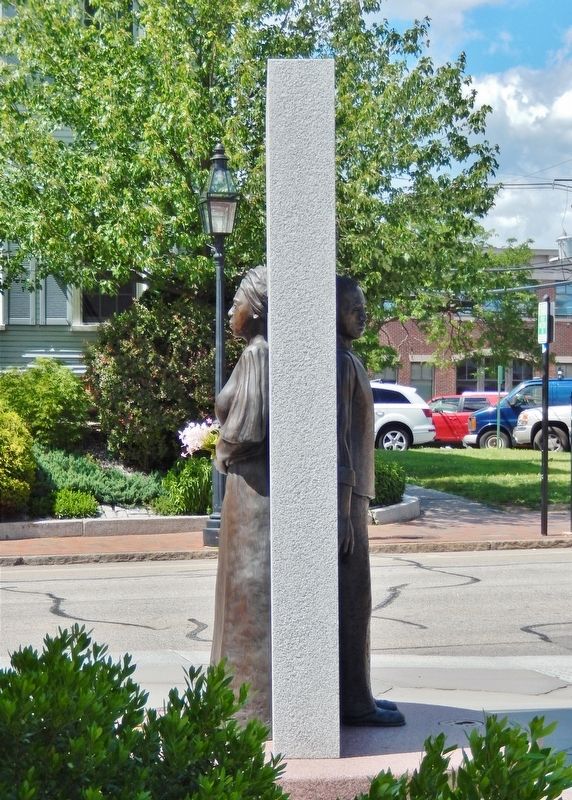
Photographed By Cosmos Mariner, June 28, 2017
5. African Burying Ground Memorial Sculpture (side view)
Together, as each figure reaches around the edge of the granite slab towards the other, they physically embody the separation and uncertainty experienced by those brought here as captives as well as their perseverance.
Also see . . . Portsmouth African Burying Ground. African Burying Ground website homepage
During the 1700s when the Burying Ground was actively used, the area that is now Chestnut Street was the undeveloped outskirts of town. Over time, as Portsmouth grew during the late 1700s and throughout the 1800s, the African Burying Ground was paved over and built over and many forgot of its existence. Today, we recognize this important place as the only known African Burying Ground in all of New England that dates to this era. (Submitted on April 7, 2018, by Cosmos Mariner of Cape Canaveral, Florida.)
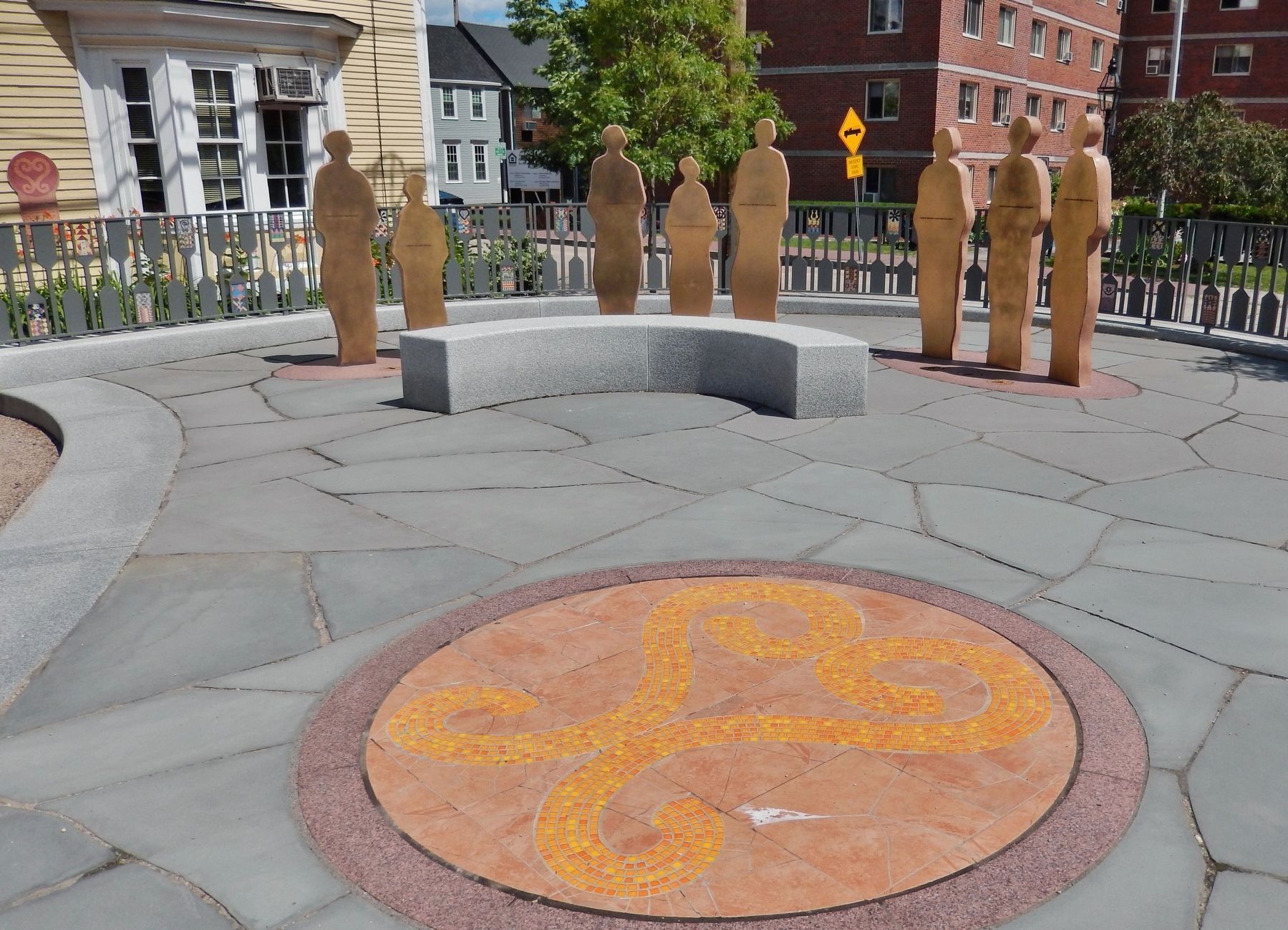
Photographed By Cosmos Mariner, June 28, 2017
6. African Burying Ground Memorial
The Adinkra figure "Sankofa" meaning "Return and Get It — Learn from the Past” forms a shield and cover for the burial vault containing the re-interred remains of those exhumed in 2003 and additional partial remains found at the site during preparations for the memorial.
These life-sized bronze silhouettes represent the collective community of greater Portsmouth, gathered with resolve to acknowledge, protect and pay homage to the souls whose remains were uncovered in 2003.
These life-sized bronze silhouettes represent the collective community of greater Portsmouth, gathered with resolve to acknowledge, protect and pay homage to the souls whose remains were uncovered in 2003.
Credits. This page was last revised on November 29, 2021. It was originally submitted on April 7, 2018, by Cosmos Mariner of Cape Canaveral, Florida. This page has been viewed 349 times since then and 13 times this year. Photos: 1, 2, 3, 4, 5, 6. submitted on April 7, 2018, by Cosmos Mariner of Cape Canaveral, Florida. • Bill Pfingsten was the editor who published this page.
